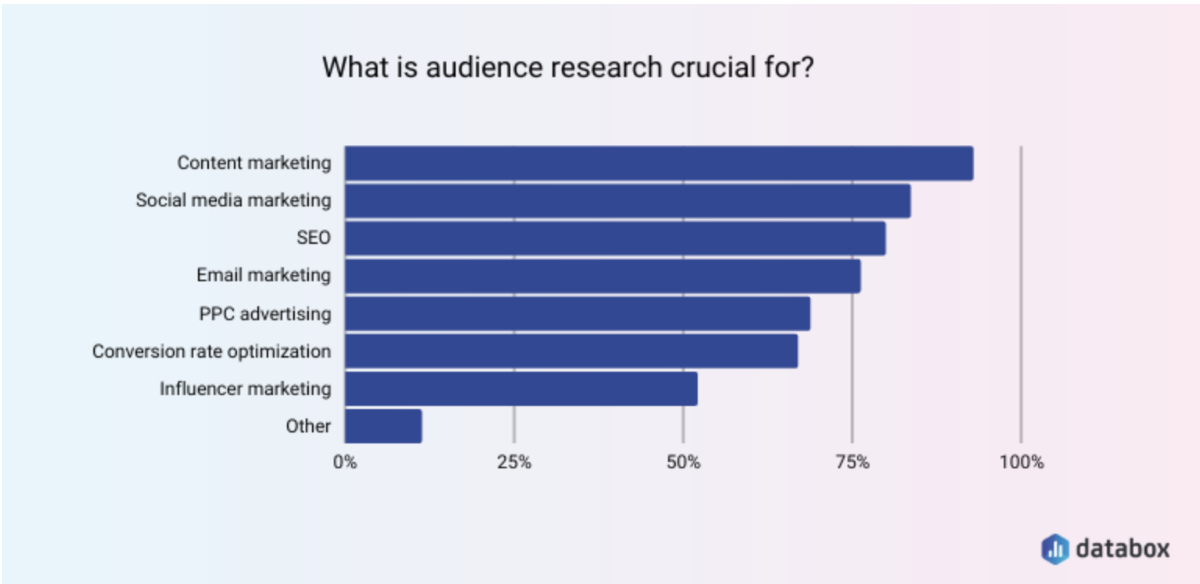
Understanding who your audience is, where they are online, and what motivates them enables you to tailor your marketing efforts effectively. By conducting market research, analysing competitors, creating audience personas, and adapting your strategy, you can engage with your audience more meaningfully and drive business growth.
In this Article:
- Why you need to know your audience
- Identifying the right platforms
- Market Research
- Competitor analysis
- Audience Personas
- Adapting your strategy
- Final Thoughts
In today’s digital climate where we are bombarded all day, with messages advertising a variety of products and services, from our social media feeds, to posters at the train station. With all this noise, it is now something that more and more people are tuning out, making it more and more difficult to get your potential customers to notice you. Sending out general messages to the world, with the hope that the right people will see it, is not likely to get you far when advertising your business.
This is why identifying your target audience is a crucial step in developing an effective marketing strategy. Understanding who your audience is and what they want allows you to tailor your messaging and content to their specific needs, increasing the likelihood of engagement and conversions.
By understanding who they are, where they are located online, what motivates them, and how to address their pain points with relevant content – you can create more impactful campaigns that resonate with them on a deeper level.
Why you need to know your audience
Understanding your audience is a fundamental aspect of successful marketing and business strategy. For example, a deep comprehension of your audience enables the creation of tailored content that might strike a chord. This not only cultivates loyalty and relationships but also drives business growth, making it an indispensable strategy for success!Knowing your audience involves market research, creating detailed customer personas, identifying the characteristics and needs of your target audience, and then tailoring your marketing efforts to resonate with them effectively.
What is a Target Audience?
A target audience refers to the specific group of people you aim to reach with your products, services, or content. This group may share common characteristics, interests, and needs that make them more likely to be interested in what you offer. For example, these characteristics might include demographics like age, gender, location, income level, and education.
Knowing your target audience involves delving deeply into comprehending your potential customers on an intimate level. This encompasses understanding their challenges, desires, aspirations, and the specific solutions they actively seek.
You may be wondering how knowing your target audience can help your business.
Simply put, the more precise and detailed your understanding of your target audience, the better you can tailor your marketing strategies to meet their specific needs.
When looking at your marketing strategy overall, knowing your target audience is absolutely crucial for how, where and what you will be doing to advertise and engage with your audience.
The image below demonstrates where understanding your audience can help with your marketing.

(source)
Content Marketing naturally came out on top, think of it as ‘you can’t sell everything to everyone’. In this instance, content marketing needs to be specific to the individuals you’re advertising to. It’s highly likely that a man in his 50s won’t want to see content on vegan makeup. With this in mind, you can imagine how knowing your audience helps you to save time in the long run.
One thing to remember is that 80% of consumers prefer to do business with a brand that offers personalised interactions. If you know your audience, you can ensure that aspects of your strategies are personalised, which can help to build relationships and ROI.
Why waste time, resources and money on people that won’t convert into business?
Identifying the right platform to market your business is essential for success. With the multitude of platforms channels available today, it’s crucial to focus your efforts where your target audience is most active and receptive. Here are some steps to help you identify the right platform:
How to find the best platform for your target audience:
Know Your Audience: Start by understanding your target audience’s demographics, behaviours, and preferences. Are they predominantly active on social media, do they prefer email communication, or do they engage more with traditional advertising channels like print or television?
One way to figure this out is to research demographics. Younger generations typically prefer to use video based socials. Such as Youtube (84%) and Tiktok (61%). If you’re targeting an older generation, it would probably be more beneficial to market your business using platforms like Facebook.
Research the user base of each platform to see if it aligns with your audience’s profile.
Analyse Your Competitors: Investigate where your competitors are marketing their businesses. If they’ve found success on particular platforms, it’s a good indicator that those platforms might work for your business too.
One way to look at this is to go to your competitors’ social pages, look at their followers, engagement and what sort of posts are they sharing. Which of their posts are getting the highest level of interaction?
Consider the Nature of Your Product or Service: The nature of your product or service can also influence your choice of platform. Visual products may thrive on platforms like Instagram, while B2B services might find better success on LinkedIn or Facebook.
Set Clear Goals: Define your marketing objectives. Are you looking to increase brand awareness, drive website traffic, generate leads, or boost sales? Different platforms can excel at achieving specific goals.
Step 2: Market Research
Understanding your target audience’s demographics and psychographics is essential for effective marketing. Demographics provide the foundational characteristics of your audience, helping you reach the right people.
Psychographics offer deeper insights into their values and motivations, enabling you to create personalised, engaging content. Knowing this not only maximises the impact of your marketing efforts, but also helps you to build stronger connections with your audience, resulting in higher engagement, brand loyalty, and increased conversions.
Demographics
This refers to the statistical data that characterises a specific group of people. This includes;
- Age
- Gender
- Location
- Income
- Education
- Marital Status
- Occupation
These factors help you define the basic profile of your audience. For example, if you’re marketing luxury cars, your target audience’s demographic might include individuals aged 35-55, residing in upscale urban areas. By identifying these demographics, you can tailor your messaging and choose the most appropriate marketing channels to reach this group effectively.
Psychographics
These delve deeper into understanding the psychological and emotional aspects of your audience. This includes their;
- Values
- Interests
- Hobbies
- Lifestyle Choices
- Attitudes and behaviours
Psychographics reveal what motivates your audience, their pain points, and their aspirations.
Going back to the luxury car example, understanding your audience’s psychographics may reveal that they value status, appreciate craftsmanship, and have a desire to stand out from the crowd. Armed with this knowledge, you can create marketing campaigns that resonate with their values and emotions.
How can you use this information to identify your target audience?
To figure out your target audience effectively, start with demographic data to build a basic profile, and then refine your understanding with psychographic insights. This combined knowledge allows you to tailor your messaging and marketing strategies in a way that not only reaches your audience but also speaks directly to their needs and desires.
Step 3: Competitor Analysis
One powerful method that can help you in identifying your target audience is competitor analysis. By analysing your competitors, you can gain valuable insights into the preferences, behaviour, and demographics of your potential customers.
Competitor analysis is great for identifying gaps in the market that your competitors might be missing. When studying your competitors, consider the content they’re sharing. You can use this to pinpoint where they fall short. Knowing these gaps can serve as a valuable opportunity to tailor your content.
This is also useful as it can reveal how your target audience behaves online. By examining your competitors’ websites, social media profiles, and engagement metrics, you can discern the type of content that resonates with your audience, and the platforms they use. Knowing and analysing the strengths and weaknesses of your competitors will ultimately help you refine how you approach your target audience.
Step 4: Create an Audience Persona
Crafting an audience persona is a fundamental step in successful marketing and content creation. This involves creating a detailed, ‘semi-fictional’ representation of your ideal customer.
How do Audience Personas work?
Audience personas are representations of your ideal customers, constructed based on data and research. They work by providing a clear and detailed picture of who your target audience is.
You can then use this information to help you tailor your marketing efforts, content, and product development to align with the specific needs and preferences of your audience. By understanding your personas, you can create more relevant and effective marketing strategies, which will help you to attract and engage the right customers.
Heres how to effectively craft an audience persona
Gather Data: Start by collecting data on your existing customers or potential target audience. This may include demographics, behaviour, preferences, and pain points. You can utilise surveys, analytics, social media insights, and customer feedback to gather this information.
Segment Your Audience: Divide your audience into distinct segments based on common characteristics. These could be age, gender, location, interests, or purchase history. Segmenting helps create personas that are more specific and relevant!
Give Your Persona a Name: Humanise your persona by giving them a name. This makes it easier to visualise and connect with them. For example, if you’re targeting a tech-savvy millennial, you might name your persona “Tech-Savvy Taylor.”
Create a Detailed Profile: Develop a comprehensive profile for your persona. Include their age, gender, job title, income level, hobbies, goals, challenges, and more. The more details, the better.
Identify Pain Points and Goals: Understand what problems your persona faces and what goals they want to achieve. This insight allows you to tailor your products or services to address their specific needs.
Craft Relevant Content: Now you know all of the prior points you can use your guide to tailor your content creation. Make sure that your messaging, tone, and content resonate with the persona’s interests and concerns. This makes your content more engaging and appealing.
Continuously Update: Audiences evolve, so it’s crucial to keep your personas up to date. Regularly gather new data, adjust personas as needed, and refine your marketing strategies accordingly.
Create your own compelling Personas to truly understand your audience with our free download:

Step 5: Adapt your strategy
Constantly adapting and learning about your target audience is essential. The main thing to keep in mind is that customer preferences, behaviour, and demographics all evolve over time, these are influenced by changing trends and technologies.
By staying attuned to these shifts, you can remain relevant and responsive to your audience’s ever-changing needs. Adapting to this allows you to tailor your products, services, and marketing strategies effectively, ensuring you deliver value and engagement. Moreover, it helps you stay ahead of the competition and foster long-term relationships with your clients. Ultimately, the ability to adapt and connect with your target audience is a competitive advantage that can make or break your business.
Final thoughts
In conclusion, identifying your target audience is a crucial step in developing an effective marketing strategy. By understanding who your audience is, you can tailor your marketing strategies.
By analysing your audience demographics, you can look at factors such as age, gender, location, and income level to gain insights into who is already engaging with your brand.
Remember that identifying your target audience is an ongoing process. As market trends shift and consumer preferences evolve, it’s important to continuously monitor and adapt your marketing strategies to ensure you are reaching the right people with the right message.




